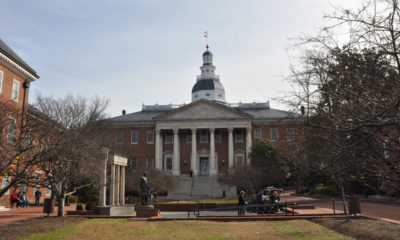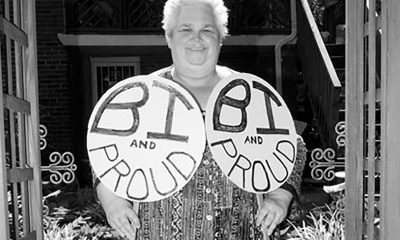a&e features
Baltimore’s ‘Visionary’ curator prepares to step down
For 26 years, Hoffberger has created a loving haven and championed LGBTQ artists
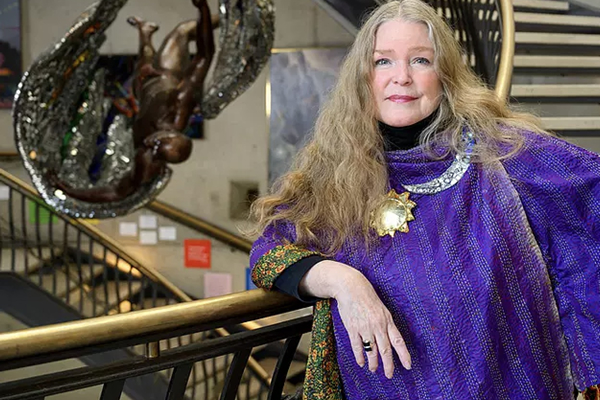
The American Visionary Art Museum in Baltimore has highlighted hundreds of artists since it opened in 1995, and works by LGBTQ artists have featured prominently in both its permanent collection and changing exhibits.
From Andrew Logan’s Cosmic Galaxy Egg sculpture to Robert Benson’s blinged-out Universal Tree of Life to Judy Tallwing’s Prayer for Peace painting, LGBTQ artists have been responsible for some of most memorable creations that visitors will see, whether they know it or not.
This pattern of inclusion is part of the legacy of museum founder, director and primary curator Rebecca Alban Hoffberger, a longtime ally of the LGBTQ community. After 26 years running the museum, Hoffberger announced in July that she plans to retire in March of 2022, and AVAM’s board has launched a search for her replacement.
But unlike some museum directors who have called attention to their recent efforts to promote greater diversity in the range of artists they show, Hoffberger said she has never set out specifically to include a certain percentage of LGBTQ artists, just as she has never set a goal for featuring a certain number of minority or female artists.
She said she simply tries to find the best artists for each show, based on the perspectives they bring and the work they produce. In many cases, she said, she doesn’t necessarily know an artist’s sexual orientation, unless their work is homoerotic or intentionally refers in other ways to their identity.
Hoffberger said her resistance to quotas is not because she’s color-blind or gender-blind.
“I would say I’m color- and race-celebratory,” she said. “There’s a quote by [Canadian writer] Dorothy Maclean: ‘Humankind trend should be to unity, not uniformity.’ That pretty much sums it up. That’s how I feel. Labels like gay or straight or bi, what do they tell you about a person? Not very much. I’m not so interested in people’s sexuality. I’m interested in the person.”
Hoffberger likens curating a museum exhibit to planning a banquet: “If you’re looking to offer…as delicious a feast as possible, it comes naturally that you would have participation by extraordinary people of every stripe.”
Located at 800 Key Highway near the city’s Inner Harbor waterfront, the museum has been designated by Congress as a “national repository and educational center for visionary art,” which is defined as works “produced by self-taught individuals, usually without formal training,” which arise from “an innate personal vision that revels in the creative act itself.”
These creators, sometimes called outsider artists, often try to make sense of the world by making art with whatever materials they have at hand, whether it’s egg shells or toothpicks or more conventional artist supplies.
Hoffberger said she prefers the term visionary artists, or intuitive or self-taught, to ‘outsider.’ But she notes that it makes sense that many LGBTQ individuals turn out to be visionary artists because of the experiences they’ve had in life. She said many members of the LGBTQ community have lived outside the mainstream in one way or another, and that has both fueled their drive to make art and informed the art they make.
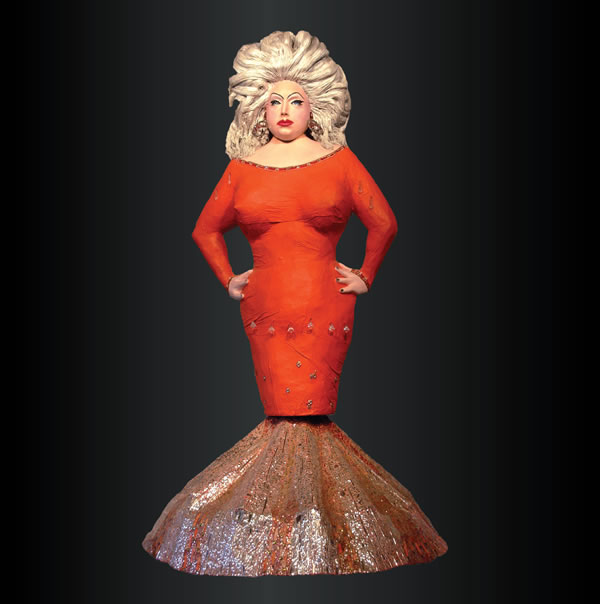
“How about you’re born into a family where all the girls are gorgeous and you’re the fat one? Or you have a deformity? There’s a myriad of ways that people feel out of step,” she said. “When the life experience is too big for words, it often will come out from non-artists as a creative expression for the first time because there are just no words for it.”
This doesn’t mean LGBTQ artists are inherently better than non-LGBTQ artists, she said.
“Better? No. But anyone who feels for any reason like an outsider, who has experience feeling like a stranger, always has a more in-depth take at reality because they are on some level on the outside…The point is that people who have that little bit of knowing what it is like to be outside the circle actually often will have a perspective that helps evolve and draw a circle.”
Something happens to people when they aren’t from the “established pack,” she said, that makes them look at the world differently and react differently and perhaps get more creative.
“When you’re not from the pack…when you’re forced out of conventional thinking because people are giving you pretty clear signals that you’re not like them in ways that they may even be hostile to, then you start to think more deeply because you can’t coast on being accepted in the same way. It’s not as easy.”
Hoffberger points to the work of gay filmmaker John Waters and his ability to capture what it’s like to live outside the mainstream.
“That’s what I think John Waters has done so unbelievably well,” she said. “He didn’t shock just to shock. He always had this softness for seeing value in people that other people would never have focused on. And in doing that, you sense that you are with someone who’s going to give you a break. That’s why he has yet another generation of fierce fans. This is a person who draws a big circle around the human family, and we’re living in a time when people are getting more and more narrow…So you want to be in the camp of championing more people, the beauty of more people, and the more diverse the better.”
As director and curator, Hoffberger said, she seeks out the best work she can find by visionary artists to incorporate in the museum’s exhibits. But rather than presenting works of visionary art as objects unto themselves, she curates exhibits that combine art, science, philosophy and humor, with an organizing theme for each show and an underlying focus on social justice and betterment.
In some cases, AVAM has explored themes that touch on gender, gender rights and human sexuality, including a 2005-2006 show entitled “Race, Class and Gender: 3 Things that Contribute ‘0’ to CHARACTER (Because being a Schmuck is an equal opportunity for everyone!) For exhibits such as that, Hoffberger said, works by LGBTQ artists can be particularly appropriate due to the artist’s point of view.
In other exhibits, she has focused on issues ranging from climate change to hunger to public health. AVAM’s next major exhibit, scheduled to open Oct. 9 and run until Sept. 4, 2022, is entitled “Healing & The Art of Compassion (and the Lack Thereof.)
Hoffberger said she doesn’t think sex or race are good ways to assess people.
“I don’t think your sexual orientation, I don’t think your color, I don’t think your religion, conveys any quality of character whatsoever,” she said. “That’s why I did that show, Race, Class and Gender. Three things that contribute zero to character but everybody is talking about all the time. I would think it would be more fair, since they’re approximately 50 percent of the population, if there were more women leaders. But do I think that because you are a woman leader you are going to be more spectacular just because of having a vagina? No, absolutely not. None of those things mean much to me, frankly.”
That goes for artists as well as elected leaders, Hoffberger said.
“I don’t even like it when I can look at a work of art and go, I know a woman did this. I really don’t like that,” she said. “I’d rather it just be kind of a soul, with different clothes on. I like magnificent souls, with whatever. And in that celebration, you have a great tenderness to be open to wherever that soul and beauty will manifest.”
AVAM has become a magnet for LGBTQ visitors, she said, because it’s a place where they feel comfortable with the art and the other patrons.
“What I love about the museum is that it is such a haven,” she said. “There are so many young teens that are transitioning, who come because, whether you’re wearing a burka or whatever, there’s a safety in being in our museum because there’s such a welcoming, loving vibe. You can see people who you can relate to not only walking through the museum but also in the art.”
Following are some of the LGBTQ artists whose work is or has been featured at the American Visionary Art Museum:
Andrew Logan, (1945- ) His works at AVAM: A 10-foot-tall sculpture of Divine, a tribute to the drag performer who starred in “Pink Flamingos,” “Multiple Maniacs,” “Hairspray” and other movies by filmmaker John Waters; Black Icarus, a figure suspended above the museum’s main staircase, and the Cosmic Galaxy Egg, an eight-foot-high sculpture on a plaza outside the museum’s Jim Rouse Visionary Center, inspired by the deep space images revealed by Hubble Telescope transmissions. Hoffberger is hoping to add a fourth work by Logan, a sculpture of the mythical creature Pegasus.
Logan was born in 1945, the third of five brothers in a family with one younger sister. In 1967 Logan graduated from the Oxford School of Architecture and spent one year in the United States working for the Virginia Historic Landmarks Commission. At the age of 27, Logan gained notoriety as the co-founder, along with Baltimore’s Divine, of the Alternative Miss World contest, an inclusive beauty contest open to transvestites, the old and the young, men and women. His contest emphasized imagination and the radiance of beauty from within. In 1979, Andrew’s Alternative Miss World contest fought off legal action from another event with the help of a budding young defense barrister – future British Prime Minister Tony Blair.
Logan is a tap dance and yoga aficionado and a prolific self-taught artist whose sculptures, mirrored jewelry, costumes, stage sets, and performance pieces have garnered a wide audience. He creates his art by using materials that are at hand, often incorporating mirror fragments and fabric remnants, and adding realistically sculpted heads and bodies. In the 1980’s Logan founded his own museum in Berriew, Wales, to house and display a portion of his work.
“The mirror of the universe has been my life for almost forty years,” the museum’s website quotes Logan as saying. “It has an energy like no other material. I have played with mirrors to create monuments, portraits, wall pieces and sculptural jewelry…My life is an artistic adventure.”
Judy Tallwing, (1945- ). Her work at AVAM: A painting entitled Prayer for Peace is part of the museum’s permanent collection. It was a gift of the artist in memory of Sashie Helene Hyatt.
Tallwing is an Apache elder, leatherwoman and multi-media artist who won the first International Ms. Leather contest in 1987. Born in Glendale, Ariz., Tallwing has childhood memories of living in the desert with her parents and seven half brothers and sisters, helping to hunt rattlesnakes, and selling rocks by the roadside. Like many Native American children, Tallwing attended both a Catholic girls’ school and Indian School. She has six children, 23 grandchildren, and seven great grandchildren.
Tallwing started making art as far back as she can remember. “We didn’t call it art, we called it making things to sell along the road to help the family survive. I used to watch my grandmother, grandfather, and my mother all doing various forms of what I now know is art, to sell, and I wanted to help.” The first thing of hers that sold was a bee sitting on a flower, painted on a rock. It sold for 25 cents.
In her youth, Tallwing did a little bit of everything, from running her own construction and leather production companies to being the executive director of a domestic violence victims’ program and running an animal rescue operation for 13 years. “I think an ‘aha moment’ for me was realizing I could go to college, even without much other schooling.”
Starting college at age 32 changed her life; she now holds both an associates’ and bachelor’s degree. She travels to what she calls “power places” and brings back tiny fragments from those places to put in every painting or sculpture that calls for them, including copper, silver, turquoise, garnet, prayer ashes, and minute crystal prayer beads.
“I love trying to bring the stories I’ve heard to life and to add the spiritual aspects of the stories through the medicine of different elements of nature,” she has said. “Each thing that lives on the earth has its own energy and I try to put those energies together to create a healing.”
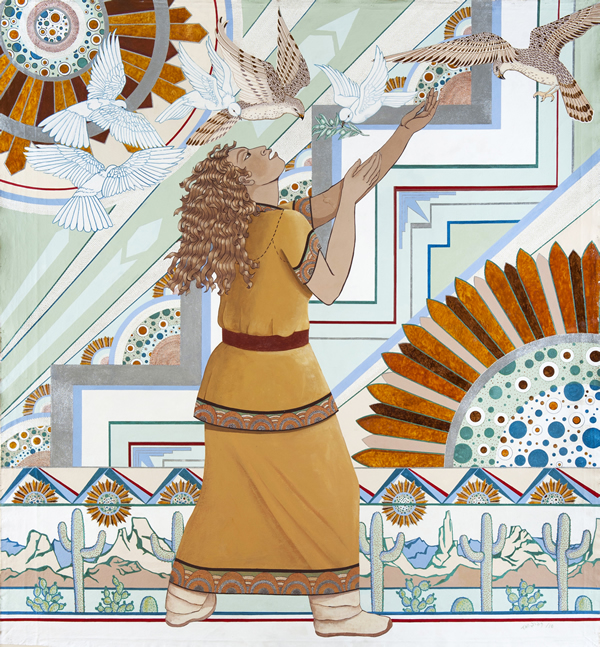
Ingo Swann, (1933–2013). His work at AVAM: The Light Bringer, a painting in the museum’s permanent collection.
Swann is best known as a pioneer in the field of remote viewing, the practice of seeking impressions about a distant or unseen target, also described as “sensing” with the mind. Swann’s high rate of success in this field led him to co-create, along with Harold Puthoff and Russell Targ, the Stanford Research Institute of Remote Viewing and the CIA Stargate Project, launched to investigate psychic phenomena in military and domestic intelligence applications.
Swann was born high in the Rocky Mountains in Telluride, Colo., on Sept. 14, 1933. His father was a truck driver and he had two sisters. He often spoke of the beauty of his surroundings as a child, particularly the crystal-clear skies where he could see the Milky Way each night.
Swann wrote that he first experienced leaving his body at the age of three, during an operation to remove his tonsils. At that time he also became aware of seeing “butterfly lights” around people, plants, and some animals, which he later learned were auras. By nine, he wrote that he’d remotely traveled to the Milky Way. He famously claimed to have sent his consciousness to Jupiter prior to the arrival of NASA’s Voyager satellite probe and accurately described many of the planet’s features, including Jupiter’s then-unknown rings.
Swann’s paintings express his passion for exploring the mysteries of the universe and recapture his visions from leaving his body, remote viewing, and seeing auras. Swann was also a musician and a writer of several books, including his autobiography, “Penetration: The Question of Extraterrestrial and Human Telepathy” (1998). He died on Jan. 31, 2013 in New York City.
Bobby Adams (1946 – ). His work at AVAM: His photographs, scrapbooks and shrines have been featured in three exhibits.
Adams is a multimedia artist and a member of filmmaker John Waters’ group known as the Dreamlanders. He was born Robert Reid Adams on Feb. 15, 1946 in Dallas, and grew up in Baltimore. His father, a former boxer and strict disciplinarian, operated a floor sanding business in Dundalk. His “beloved and gentle” mother taught school and would eventually die by suicide in 1976.
Adams graduated in 1964 from Sparrows Point Senior High School and was able to avoid being sent to Vietnam because of a hearing problem. He became a pirate radio DJ in the late 1960s, playing at gatherings around Baltimore and spinning records for a station he dubbed W.E.E.D. He assembled elaborate scrapbooks stuffed with psychedelic collages and philosophical, often humorous, musings to illustrate his DJ patter and circulate among listeners at gigs.
In 1970, he began working with John Waters, who filmed “Pink Flamingos” at the Baltimore County farm where Adams was living. Ever since, Adams has been the filmmaker’s unofficial documentarian, taking photographs on film sets and chronicling the exploits of Waters’ band of renegades, the Dreamlanders. “I never learned how to do the camera,” notes Adams. “I just point and shoot. My approach is simple: I start with love, and the camera sees it.”
A self-professed Christmas addict, Adams makes hundreds of personalized, handmade, labor-of-love holiday cards for friends and family each year. Inspired in part by Waters’ own art making and an Edward Kienholz exhibition he chanced upon, Adams began making art in 1996, after the loss of his toy poodle, Odie. He created 50 multimedia tribute pieces to Odie and installed them throughout his waterfront cottage. Before it was displayed at AVAM, Adams’s art had never been exhibited publicly. When asked if he ever had an unrealistic hope fulfilled, he said, “Yes, being included in this show.”
Robert E. Benson, (1930 – ). His work at AVAM: The shiny Universal Tree of Life visible near the museum’s main entrance on Key Highway; the fart machine in the museum’s Flatulence exhibit; the ocean beneath Andrew Logan’s Black Icarus sculpture and the sky above it, and other creations.
Benson is a popular classical music radio host who became a prolific visual artist late in life. Born in Chicago, he served in the Army from 1951-1953 as enlisted secretary to General Mark Clark, commander-in-chief of the Far East Command. From 1953-1955 he worked for the B&O Railroad as secretary to the Manager of Industrial Development, and for two years was Assistant Manager of the Baltimore Symphony Orchestra.
Benson’s radio career began in 1958 when he was program director of WFDS-FM, which two years later became WBAL-FM. He was program director and chief announcer there until 1974, when he became Director of Audience Development for the Baltimore Symphony.
In 1975, Benson became coordinator of the Maryland State Arts Council’s Community Arts Development program working to organize county arts councils in all 23 counties of Maryland. He also was in charge of grants to music organizations and individuals, and retired from his state job in 1995. In 1979 he became morning announcer for WBJC-FM, where he remained until 1986. For 10 years beginning in 1987, Benson did programming and announcing for WJHU (now WYPR). He has collected recordings for many years, with particular interest in historic performances. He has written reviews for numerous publications, including Forecast FM, Hi Fi Stereo Buyers Guide, High Fidelity and Stereophile.
Benson lives in Glen Burnie, Md., where he grows orchids in his “underground” greenhouse, a hobby of three decades, and listens to music on his elaborate surround sound system. Since 2004 he has been working with mirrors and stained glass, creating varied art and decorative pieces.
Andrey Bartenev, (1969 –). His work at AVAM: In 2007, Bartenev won first prize in the museum’s “Bra Ball,” for his black and white rubber costume and performance.
Bartenev is a Russian performer, sculptor and experimentalist who won the Alternate Miss World pansexual beauty pageant in 2018 as Miss UFO. He was born on Oct. 9, 1969 in the northernmost Arctic Circle city of Norilsk in Siberia, an industrial town famous for its reserves and production of aluminum.
Bartenev recalls “three months of total darkness, one month of really hot summer, and 15 days each for spring and autumn.” His only sibling, a sister, was 12 years older. Bartenev’s father was a coal mining engineer and his mother was an industrial safety engineer. Both worked long hours, giving Bartenev free reign to decide how he spent his time alone.
At three, Bartenev loved scissors and began to cut images and patterns from books. “We made all our toys out of snow.” At an early age, Bartenev would organize parties for his friends who were also left alone, getting them to bring over all their pets. He used plastic to sculpt little “castles” for his mice and hamsters, and made costumes for his cats and dogs.
At 16, Bartenev moved with his family to Sochi in the south of Russia — “like Miami with mountains.” In college he studied theater and directing, graduating with high honors. His first job was directing a children’s theater near Chechnya. He also danced and performed in a local cabaret.
Moving to Moscow in 1990, Bartenev supported himself doing collages and graphics and competed in the Big Arts Festival at the Baltic Sea in 1992, where he met one of the judges, Andrew Logan, co-founder of the Alternative Miss World contest. Bartenev made a Snow Queen costume out of papier-mâché that won the top prize. Logan invited him to compete in the Alternative Miss World contest in 1995, 1998, and 2002 in London. There, Bartenev also created programs for the popular BBC children’s TV show, “Blue Peter” and re-staged his original performance show, “Botanic Ballet.” In 2007, he brought his talents to Baltimore and won first prize in AVAM’s “Bra Ball.” He has said his idea of perfect beauty is his childhood vision of “black sky and white snow.”
James Franklin Snodgrass (1922–2000). His work at AVAM: An untitled painting in the permanent collection, the gift of Robert Civello.
Snodgrass was born in Harford County, Md. in 1922. The son of a schoolteacher, he painted mannequins and traveled throughout the United States after graduating from college. During World War II, he declared himself a conscientious objector and worked as an ambulance driver for a Quaker society.
Appearing on television game shows became a peculiar “hobby” for Snodgrass, who won prize money on several occasions. In the late 1950s, he became the focus of public attention after he exposed fraudulent practices on the popular quiz show, Twenty-One. His story inspired Robert Redford’s 1994 film, “Quiz Show.”
Afterwards, Snodgrass grew increasingly reclusive and focused on his art. He was evasive, even secretive, about the untitled painting in AVAM’s collection, which took many years to complete. He died from cancer in early 2000.
Located at 800 Key Highway, the American Visionary Art Museum is open from 10 a.m. to 5 p.m. Wednesdays through Sundays. Advance online purchase of a timed ticket is required to visit the museum. Visiting just the museum store, Sideshow, is free and does not require purchase of a ticket.
a&e features
Have yourself a merry John Waters Christmas
Annual holiday show returns to Alexandria and Baltimore
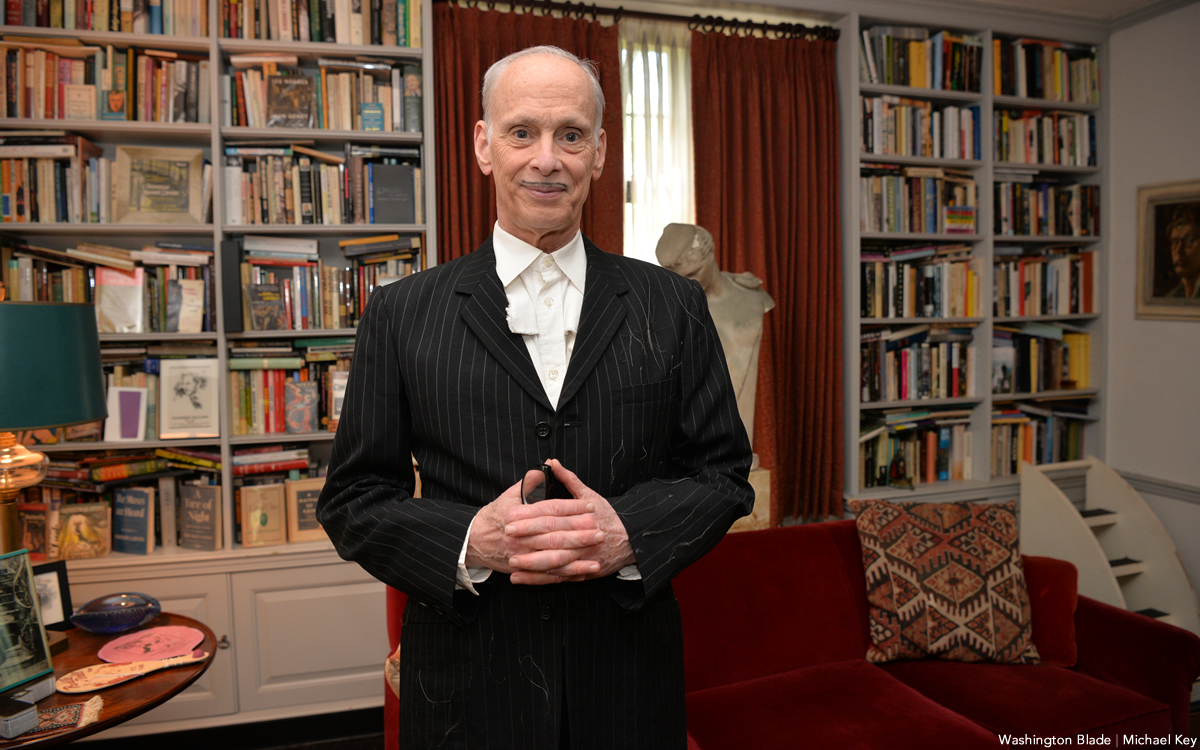
When it comes to iconic Christmas scenes in movies, none can top the tree-toppling tantrum thrown by cha-cha heels-deprived Dawn Davenport in John Waters’s fifth full-length feature “Female Trouble” from 1974. Therefore, it’s not surprising that Waters continues to make art out of Christmas, performing his spoken word Christmas tour in cities across the country. Waters has even more reason to celebrate with the release of his new red vinyl 7” single, a cover of Little Cindy’s “Happy Birthday Jesus (A Child’s Prayer)” on the A-side, and “A Pig Latin Visit From St. Nicholas” on the B-side. If you’re still looking for unique Christmas gifts, consider this record. As always, John was kind enough to make time for an interview in advance of his tour dates.
BLADE: John, in preparation for this interview with you, I went back and listened to Little Cindy’s original rendition of “Happy Birthday Jesus (A Child’s Prayer)” on your “A John Waters Christmas” CD.
JOHN WATERS: One thing I did, if you notice, I make the same stumble in my recording that she did in the original.
BLADE: It sounded to me like she got choked up.
WATERS: No, I think she just stumbles over a word, so I stumbled over the same word. It’s appropriation, insanely.
BLADE: Is this a song you first became aware of in your youth or when you were an adult?
WATERS: When I was doing the Christmas album, I had this friend named Larry Benicewicz. He was kind of my idea man with music. He knew every single old record. I would say to him, “Weird Christmas songs,” when we were doing a soundtrack, or a song about bears, or a song about this, and he would give me all these tapes. It was one of the ones he played for me. A lot of the songs I put in my movies and on my records, I did know as a kid. I did not know this one, but I immediately embraced it. I don’t think it’s campy. I think it really is spiritual in a weird way. My doing it makes it a novelty record. I am really for novelty records, and there aren’t any anymore. Why was there not a COVID novelty record? That’s insane. The dance “The Bug” that’s on the “Hairspray” soundtrack would be perfect for COVID.
BLADE: The thing that struck me was that for a Christmas song in the voice of a child, a kind of death pall hangs over it, with lines like, “If I was good you’d let me live with you” and “they nailed you to the cross, they wanted you to die.”
WATERS: All of it! When I see children at midnight mass kneeling in front of a nude man nailed to a cross, I feel like I’m at The Eagle! It is S&M, it’s creepy. I took the same cover (photo) from her record to parody and put my face on it. The same thing I did with The Singing Dogs last year when I covered (their version of) “Jingle Bells.” I’m really into novelty records. I love them and I’m trying to bring them back. I don’t expect anybody to ever play these records. Even The Singing Dogs one said on it, “Please do not play this record” [laughs]. And the flipside, the Pig Latin version, is almost impossible to listen to.
BLADE: I’m so glad you mentioned that. “A Pig Latin Visit From St. Nicholas” reminded me of the lost art of speaking in Pig Latin. I also recall watching the PBS series “Zoom” as an adolescent and learning to speak “ubbi dubbi,” a distant relative of Pig Latin. Do you think that the time is right for a Pig Latin or ubbi dubbi revival?
WATERS: Here’s the thing, I never could pick up any language, except Pig Latin. I’ve been in every foreign country. Foreign countries have given me money to learn to speak the language. I can never do it! But Pig Latin…my parents and other parents in the ‘50s spoke Pig Latin so kids couldn’t understand what they were saying. Then my mother taught it to me, and I used it. The hardest take to shoot in “Pink Flamingos” was not eating the dog shit. It was when the cast skipped, in one take, saying “E-way, are-yay e-they ilthiest-fay eople-pay in-hay e-they ole-hay ide-way orld-way.” We’re the filthiest people in the whole wide world in Pig Latin. We had to do so many takes so they could do it once without screwing it up. In “Polyester,” Edith (Massey) answers the phone, “ello-hay.” I did a photo piece where it was all subtitled in Pig Latin. Like “osebud-Ray” (from “Citizen Kane”) or in “Streetcar,” “ella-Stay!” [Laughs] All the iconic dialogue translated into Pig Latin. My assistant who helped me do it, had never heard of Pig Latin. She really got good at it because she lived in many foreign countries and can pick up languages. But it’s not that easy to do it correctly and read it. Your computer will translate into Pig Latin.
BLADE: AI understands Pig Latin?
WATERS: I guess that’s AI. It wasn’t 100% right, but it was close. I can speak it if I look at it, but just do a bit at a time. It was a challenge that no one would possibly care about or want to do.
BLADE: I think you pulled it off very well.
WATERS: If you want people to leave on Christmas morning, you put it on. That’s how you get your guests to leave. It’s time to go.
BLADE: Ood-gay i-bay! How did your relationship with record label Sub Pop, which released 2021, 2022, 2024, and new 2025 holiday singles, come about?
WATERS: I believe the first thing I did for them was “Prayer to Pasolini.” They came to me through Ian Brennan. He’s won a couple Grammys for World Music, but he is also is one of my agents who does the Christmas tour and a lot of my shows, anything with music. He helped me arrange each one of the songs. He had a relationship with Sub Pop. It was perfect. My friends in Baltimore, (the band) Beach House, have had huge success.
BLADE: That’s right, they’re on Sub Pop!
WATERS: Yes! I’m happy to be on it. I’ve even been to the warehouse and posed for pictures like Jackie Suzanne used to do.
BLADE: Is there any chance that “A John Waters Christmas” might be reissued on vinyl by Sub Pop?
WATERS: No. It’s such a nightmare to get the rights and to renew them. You have to find the publisher and the writer, and they usually hate each other. It doesn’t matter if it’s obscure or famous, it’s hard to get. You have to make the deal. The singer doesn’t get anything unless they play it on the radio. It would be so complicated legally, and there would be such a [laughs] tiny audience for it. I hope it will come out again. The same thing with the one for Valentine’s Day. I had two of them that did quite well when they came out; “A Date With John Waters and “A John Waters Christmas.” The “John Waters Christmas” album is still the soundtrack that plays whenever I’m doing my spoken word Christmas show as people are entering the theater.
BLADE: Aside from your annual Christmas show tour, what else do you do for the holidays now, and are there any traditions that you’ve carried over from your family?
WATERS: Certainly! I have two sisters, my brother’s widow, and me, so there are four and we take turns each year to have the Christmas dinner. Mine was last year. An entire sit-down dinner. Mom’s China, the silverware, the entire full dinner. It’s pretty traditional. I don’t have a Christmas tree, but I do decorate the electric chair from “Female Trouble.” That is a tradition in my family. We do have Christmas decorations, but they’re usually weird ones that fans sent me. I have one with Divine knocking over the Christmas tree, and the Christmas tree lights up, all sorts of amazing things. There is definitely a tradition here that might be a little altered, but it is definitely a tradition. I used to have a giant party every year, but COVID ended that. I still wouldn’t want 200 people in my house breathing right now.
BLADE: I was looking at your tour schedule and wondered if there are any new cities in which you’ve never performed the John Waters Christmas show that have been added to this year’s schedule?
WATERS: I don’t think there’s a city in America in which I haven’t done one show! The only places I haven’t been to are Hawaii and Alaska. I could do it there, but it’s too long on a tour. I can’t think of a city I haven’t played in in America over the last 50 years. The Christmas show is completely different every year. It doesn’t matter if you saw it last year.

Some gifts scream practical, others whisper luxury, and a few flat-out blur the lines. From cocoa that feels ceremonial to a cologne that linger like a suggestive smirk, this year’s ultimate gift picks prove that thoughtful (and occasionally naughty) presents don’t have to be prosaic. Welcome to your holiday cheat sheet for festive tangibles that get noticed, remembered, and maybe even result in a peck of gratitude planted under the mistletoe. Consensually, of course.
Amber Glass Champagne Flutes
Pop the champs – but make it vintage. These tulip-shaped stunners in amber-tinted glass bring all the Gatsby vibes without the Jazz-age drama. Whether you’re toasting a milestone or celebrating a Tuesday, their seven-ounce capacities and hand-wash-only care make ‘em as practical as they are pretty. Pair with a thoughtful bottle of bubs and gift with a glittering wink. $18, NantucketLooms.com
Disaster Playbook by Here Comes the Apocalypse
Because the end of the world shouldn’t be a solo act, this spiral-bound guide is your step-by-step roadmap to surviving and thriving when everything else goes sideways, which might be sooner than you think. Packed with checklists, drills, and a healthy dose of humor, it’s like a survival manual written by your most prepared (and slightly snarky) friend. Whether you’re prepping for a zombie apocalypse or, more realistically, REVOLUTION!, this playbook’s got your back. $40, HereComesTheApocalypse.com

Wickless Vulva Candles
Bold, luxurious, and completely flame-free, CTOAN’s wickless candles melt from beneath on a warmer, releasing subtle, sophisticated fragrances, like sandalwood or lavender. The vulva-shaped wax adds a playful, provocative element to any space –perfect for a bedroom, living room, or anywhere you want elegance with an edge. A gift that celebrates form, intimacy and self-expression, no fire required. $39, CTOANCO.com
Villeroy & Boch Royal Classic Christmas Collection
Every meal is a mini celebration – with whimsy at every place setting – in Villeroy & Boch’s Royal Classic festive dinnerware collection that hits all the right notes. Made from premium German porcelain, it features nostalgic little toys, nutcrackers, and rocking horses in delicate relief, giving your holiday spread a playful but refined twist. Dishwasher- and microwave-safe, it’s luxe without the fuss. Gift a piece to a special someone, or start a collection they’ll use (and show off) for years to come. $22-$363, Villeroy-Boch.com
Greenworks Electric Lawnmower
You a ’hood queen who considers lawn care performance art – or just wants to rule the cul-de-sac in quiet, emission-free glory? Greenworks’ zero-turn electric mower has the muscle of a 24-horsepower gas engine but none of the fumes, drama or maintenance. Six 60V batteries and a 42-inch deck mean you can mow up to two-and-a-half acres on a single charge – then plug in, recharge, and ride again. It’s whisper-quiet, slope-ready, and smooth enough to make you wonder why you ever pushed anything besides your queer agenda. The perfect gift for the homeowner who loves sustainability, symmetry, and showing off their freshly striped yard like that fresh fade you get on Fridays. $5,000, GreenworksTools.com
Molekule Air Purifier
For the friend who treats their space like a sanctuary (or just can’t stand sneezes), the Molekule Air Pro is magic in motion. Covering up to 1,000 square feet, it doesn’t just capture allergens, VOCs, and smoke – it destroys them, leaving your air feeling luxury-clean. FDA-cleared as a Class II medical device, it’s serious science disguised as modern design. Gift it to your city-dwelling, pet-loving, candle-burning friend who likes their living room as pristine as their Instagram feed. $1,015, Molekule.com
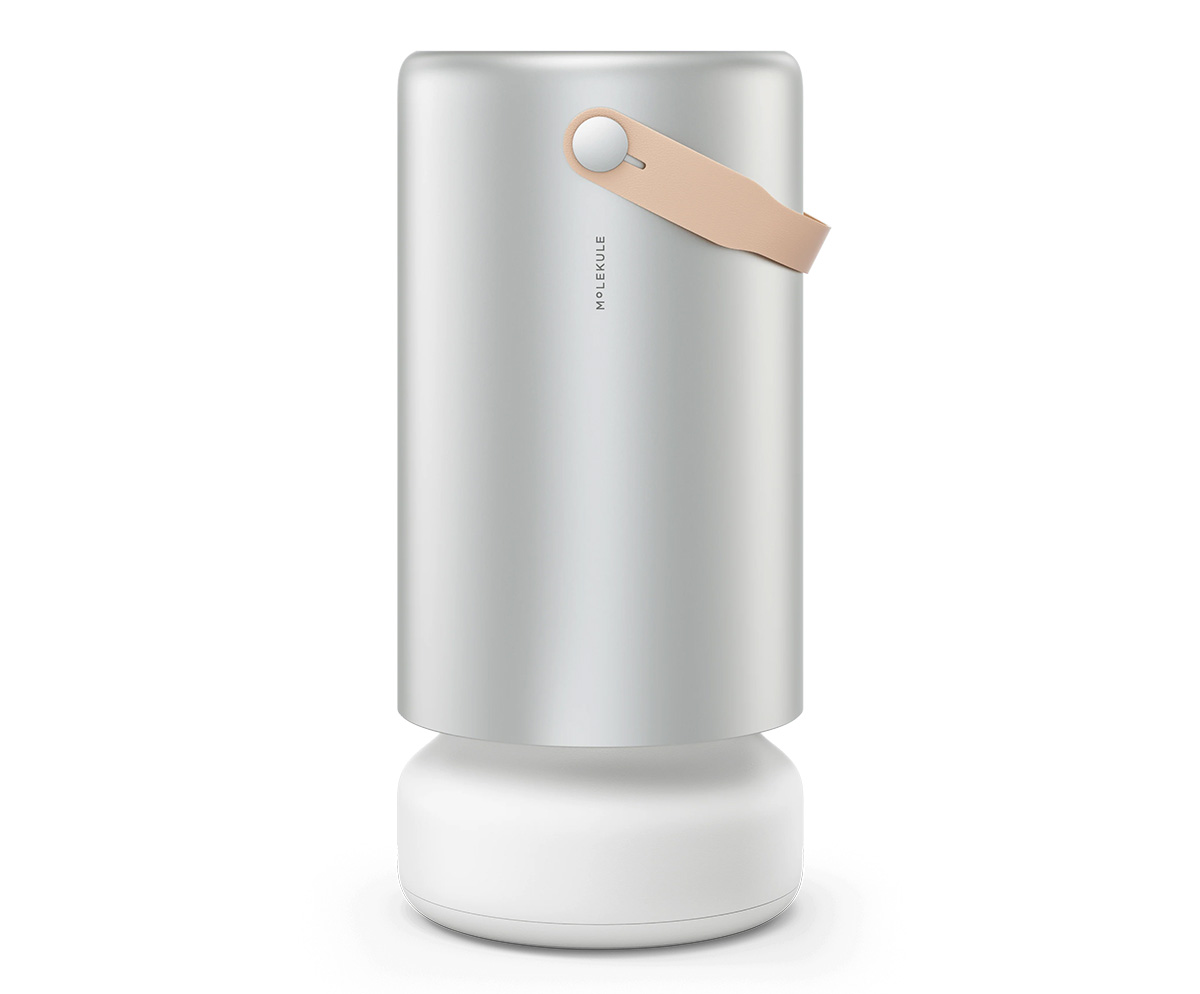
Cipriani Prosecco Gift Set
Effervescent with stone-fruit sweetness and a touch of Italian flair, the Cipriani Bellini & Prosecco gift set brings brunch-level glamour to any day of the week. The Bellini blends rich white-peach purée with sparkling wine, while the dry ’secco keeps things crisp and celebratory. Pop a bottle, pour a flute, and suddenly winter weeknights feel like a party – even with your pants off. $36, TotalWine.com
Woo(e)d Cologne
British GQ recently crowned Woo(e)d by ALTAIA the “Best Date Night Fragrance,” and honestly, they nailed it. Confident without being cocky – smoky gaïac and Atlas cedarwood grounds the room while supple leather and spicy cardamom do all the flirting – it’s a scent that lingers like good conversation and soft candlelight. Gift it to the one who always turns heads – or keep it for yourself and let them come to (and then on) you. $255, BeautyHabit.com

Lococo Cocoa Kit
Keep the run-of-the-mill mugs in the cabinet this Christmas and pull out Lococo’s handcrafted Oaxacan versions that demand you slow down and sip like it matters. Paired with a wooden scoop, rechargeable frother, and Lococo’s signature spice hot-chocolate blend (vegan, gluten-free, with adaptogenic mushrooms), this holiday kit turns Mexi-cocoa into a mini ritual you’ll look forward to. Perfect for anyone who loves a little indulgence with a side of ¡A huevo! energy.
Manta Sleep Mask
Total blackout, zero pressure on the eyes, and Bluetooth speakers built right into the straps, this ain’t your mama’s sleep mask — but it could be. The Manta SOUND sleep mask features C-shaped eye cups that block every hint of light while ultra-thin speakers deliver your favorite white noise, meditation, or late-night playlist straight to your ears. With 24-hour battery life, breathable fabric, and easy-to-adjust sound, it turns any bed (or airplane seat) into a five-star sleep suite. Perfect for anyone who treats shut-eye like an art form (or just wants to escape their roommate’s late-night bingin’ and/or bangin’). $159, MantaSleep.com

Shacklelock Necklace
Turn the industrial-chic vibe of a shackle into a sleek statement. Mi Tesoro’s platinum-plated stainless-steel necklace sits on an 18-inch wheat chain, featuring a shackle-style latch pendant that’s waterproof, tarnish-free, and totally fuss-les. Beyond style, it nods to a classic gesture in the queer leather community: replacing a traditional Master lock with something elegant to quietly signal belonging to someone special. Wear it solo for a minimalist edge or layer it like you mean it; either way this piece locks in both your look and your intentions. $90, MiTesoroJewelry.com
Parkside Flask Mojave Edition
Wine nights get a desert glow-up with Parkside’s limited-edition 750-milliliter all-in-one flask draped in sun-washed bronze and badland hues like sage, sand, and terracotta – with magnetic stemless tumblers that snap on for effortless shareability. It keeps your vino chilled for 24 hours, pours without drips (no tears for spilled rosé, please), and even lets you laser-engrave your own mantra or inside joke. Perfect for picnics, surprise rooftop clinks, or gifting to your favorite wine (or desert) rat. $149, HighCampFlasks.com
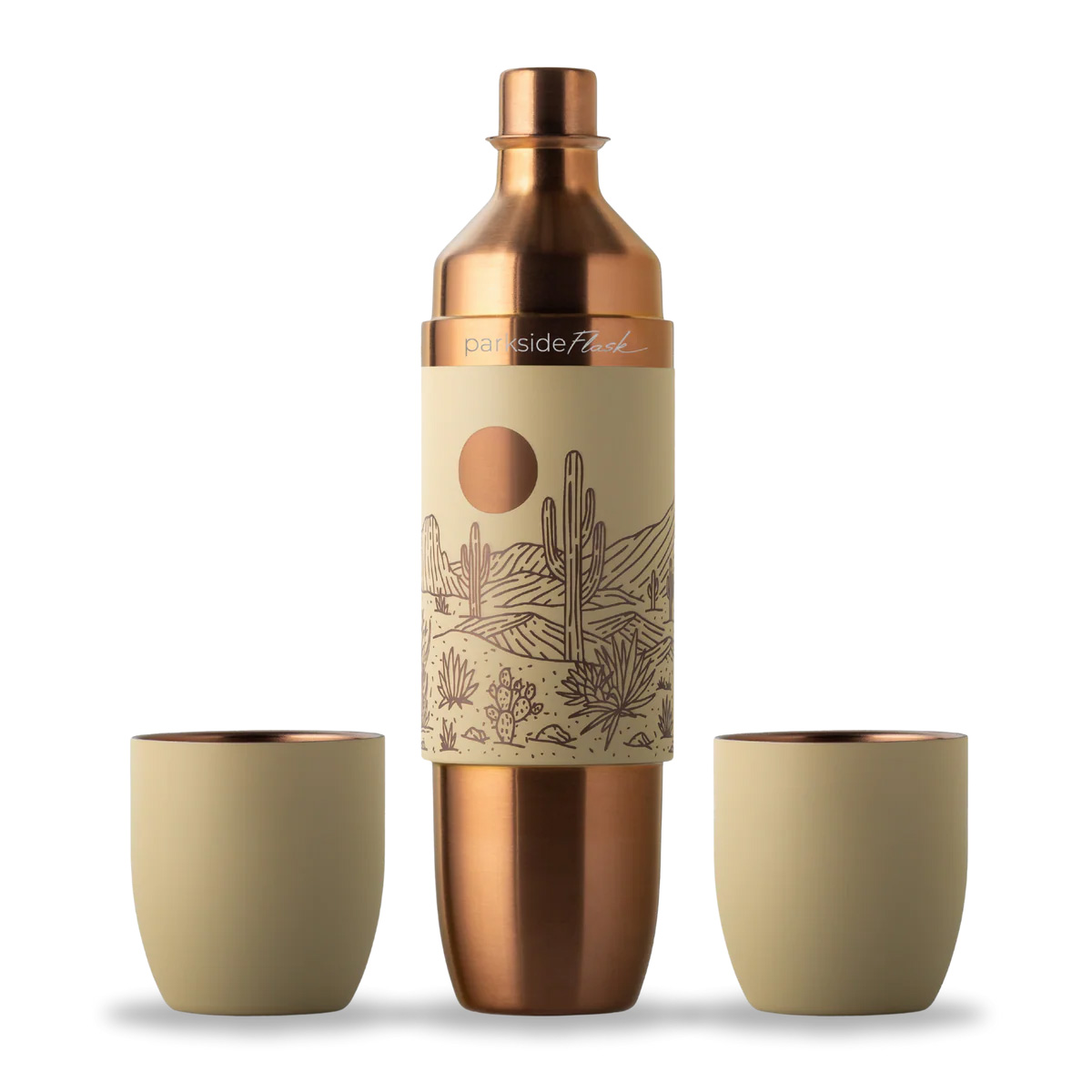
Mikey Rox is an award-winning journalist and LGBT lifestyle expert whose work has published in more than 100 outlets across the world. Connect with him on Instagram @mikeyroxtravels.
a&e features
Meet Mr. Christmas
Hallmark’s Jonathan Bennett on telling gay love stories for mainstream audiences
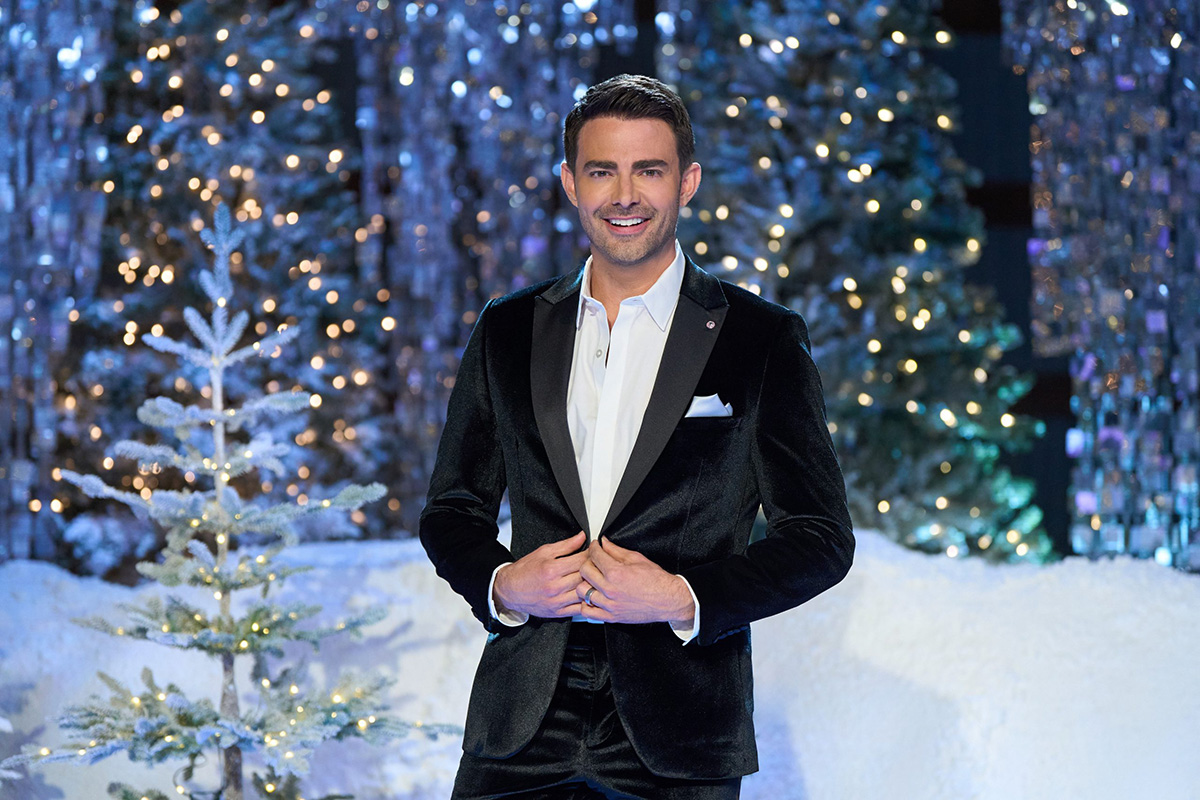
Jonathan Bennett believes there are two kinds of people in the world — those who love Hallmark movies and liars. And in Season 2 of Finding Mr. Christmas, which the Mean Girls star co-created with Ben Roy, Bennett is searching for Hallmark’s next leading man.
“It’s so fun for people because everyone in their life has someone they know that they think should be in Hallmark movies, right? The UPS driver, the barista at the coffee shop, the dentist,” Bennett says. “So we’re testing their acting abilities, we’re testing who they are, but we’re also looking for that star quality — the thing that makes them shine above everyone else. It’s almost something you can’t explain, but we know it when we see it.”
Season 2’s cast includes a former NFL player for the Green Bay Packers, a few actors, and a realtor. The 10 men compete in weekly festive-themed acting challenges, one of which included having to ride a horse and act out a scene with Alison Sweeney. The contestants were chosen from a crop of 360 potential men, and Bennett gives kudos to the show’s Emmy-nominated casting director, Lindsay Liles (The Bachelor, Bachelor in Paradise).
“She has a tough job because she has to find 10 guys that are going to be good reality television, but also have the talent to act, carry a scene, and lead a Hallmark movie eventually,” he says. To be the right fit for a Hallmark leading man, Bennett singles out five key characteristics: you have to be funny, charming, kind, have a sense of humor, and you have to do it all with a big heart.
Of course, Finding Mr. Christmas wouldn’t be Finding Mr. Christmas without its signature eye candy — something Bennett describes as “part of the job” for the contestants. “I can’t believe Hallmark let me get away with this. I dressed them as sexy reindeer and put them in harnesses attached to a cable 30 feet in the air, and they had to do a sexy reindeer photo shoot challenge,” he says with a laugh. “This season is just bigger and bolder than last. People are responding to not only all the craziness that we put them through, but also comparing and contrasting the guys in their acting scenes when we do them back-to-back.”
Season 1 winner Ezra Moreland’s career has been an early testament to the show’s success at finding rising talent. On seeing the show’s first winner flourish, Bennett says, “Now to watch him out in the world, just booking commercial after commercial and shining as an actor and a model, I think the show gave him the wings to do that. He learned so much about himself, and he took all that into his future auditions and casting. He just works nonstop. I’ve never seen an actor book more commercials and modeling gigs in my life.”
Bennett has been a star of plenty of Hallmark movies himself, including the GLAAD-award-winning The Groomsmen: Second Chances, which makes him a fitting host. Among those movies are 2020’s Christmas House, which featured the first same-sex kiss on the network and had a major impact on Bennett’s career as an openly gay man. “Hallmark’s been so great about supporting me in queer storytelling. But again, I don’t make gay movies for gay audiences. I make gay love stories for a broad audience, and that’s a huge difference, right? We’re not telling stories inside baseball that only the gay community will understand.”
He continues, “The backdrop of a Hallmark Christmas movie is very familiar to these people who watch. And so when you tell a gay love story, and you tell it no differently than a straight love story in that space, they’re able to understand. It’s able to change hearts and minds for people who might not have it in their lives.”
While Hallmark has become a major staple of Bennett’s career, he started off wanting to be a Broadway actor. And before the first season of Finding Mr. Christmas aired, Bennett took a break from TV to make his Broadway debut in Spamalot, replacing Michael Urie as Sir Robin and starring alongside Ethan Slater and Alex Brightman.
“That was my dream since I was five years old – then I booked a movie called Mean Girls, and everything kind of changes in your life. You no longer become a person pursuing Broadway, you become a part of pop culture,” Bennett recalls. “And to be honest, when I hit 40, I was like, ‘I’m probably never going to get to live that dream.’ And that’s okay, because I got to do other dreams and other things that were just as cool but different. So I honestly never thought it would happen.”
Bennett is still determined to make his way back on Broadway with the right role — he calls Spamalot the “best experience” of his life, after all — but he’s got another Hallmark show lined up with Murder Mystery House, which he co-created. The show was recently greenlit for development and intends to bring the Hallmark mystery movie to life. “It’s kind of like our version of The Traitors,” Bennett admits.
Looking back on both seasons, Bennett says that what makes Finding Mr. Christmas stand out in the overcrowded reality TV landscape is that everyone involved makes it with heart: “This isn’t a show where you’re going to watch people throw drinks in each other’s faces and get into big fights. The thing that has amazed me so much about this show, the more we’ve done it, is that every season, 10 guys come in as competitors, but they leave as a family and as brothers. That’s something you don’t get on any other network.”
Finding Mr. Christmas airs every Monday on Hallmark through December 20, with episodes available to stream on Hallmark+.

